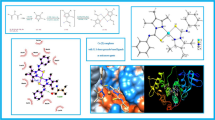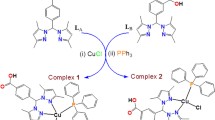Abstract
Copper-based complexes have various applications in the current era, particularly in the field of pharmaceutical and biochemistry. Four types of the bis(pyrazolyl) borate-based ligands that abbreviated K[H2B(Pz)2] (1), K[H2B(PzMe2)2] (2), K[H2B(PzMe3)2] (3), K[H2B(PzPhMe)2] (4) and their Cu(II) complexes (5–8) were synthesized and characterized by spectroscopic and analytical tools. An ideal square planar structure of complex (6) was confirmed by single-crystal X-ray crystallography. The anticancer potential of synthesized ligands and complexes was investigated using MTT assay against MCF-7 cell lines, and among the investigated compounds, complex [Cu(H2B(Pz)2)2] (5) showed the lowest IC50 values. Molecular docking studies indicated that copper complexes indicate a better binding energy in comparison with free ligands. Complex [Cu(H2B(PzMe2)2)2] (6) that bound to CDK2 protein and the ligand K[H2B(PzPhMe)2] (4) that bound to EGFR protein have the highest binding energy among the investigated compounds. In addition, quantitative structure–activity relationship (QSAR) studies indicated that EHOMO and dipole moment is in direct correlation with the obtained IC50 values and strongly effect on the anticancer cytotoxicity response.
Graphical Abstract














Similar content being viewed by others
References
Acilan C et al (2017) Synthesis, biological characterization and evaluation of molecular mechanisms of novel copper complexes as anticancer agents. Biochim et Biophys Acta (BBA) Gen Sub 1861(2):218–234
Aghdam EM, Barzegar A, Hejazi MS (2014) Evolutionary origin and conserved structural building blocks of riboswitches and ribosomal rnas: riboswitches as probable target sites for aminoglycosides interaction. Adv Pharm Bull 4:225
Alessio E, Guo Z (2017) Metal anticancer complexes–activity, mechanism of action, future perspectives. Wiley Online Library
Ansari A, Ali A, Asif M (2017) Biologically active pyrazole derivatives. New J Chem 41:16–41
Arami S et al (2017) Apoptosis induction activity and molecular docking studies of survivin siRNA carried by Fe3O4-PEG-LAC-chitosan-PEI nanoparticles in MCF-7 human breast cancer cells. J Pharm Biomed Analysis 142:145–154
Bayarı S, Ataç A, Yurdakul Ş (2003) Coordination behaviour of nicotinamide: an infrared spectroscopic study. J Mol Struct 655:163–170
Blockhuys S, Wittung-Stafshede P (2017) Roles of Copper-Binding Proteins in Breast Cancer. Inter J Mol Sci 18:871
Blockhuys S, Celauro E, Hildesjö C, Feizi A, Stål O, Fierro-González J, Wittung-Stafshede P (2017) Defining the Human Copper Proteome and Analysis of Its Expression Variation in Cancers. Metallomics 9:112–123
Bruijnincx PC, Sadler PJ (2008) New trends for metal complexes with anticancer activity. Curr Opin Chem Biol 12:197–206
Carmeliet P, Jain RK (2000) Angiogenesis in cancer and other diseases. Nature 407:249–257
Dwivedi J, Sharma S, Jain S, Singh A (2018) The synthetic and biological attributes of pyrazole derivatives: a Review. Mini Reviews in Medicinal Chemistry 18:918–947
Faria JV, Vegi PF, Miguita AGC, Dos Santos MS, Boechat N, Bernardino AMR (2017) Recently reported biological activities of pyrazole compounds. Bioorganic Med Chem 25:5891–5903
Gahramanova SI et al (2018) Synthesis and investigation of complex compounds of divalent manganese, copper, cobalt and zinc with tryptophan and their biological activity. Inter J Chem Sci. https://doi.org/10.21767/0972-768X.1000286
Ghorbanpour M, Soltani B, Ziegler CJ, Jamshidi-Ghaleh K (2021) Novel pyrazolate-bridged binuclear Ni (II), Cu (II) and Zn (II) complexes: synthesis x-ray crystal structure and nonlinear optical studies. Inorganica Chimica Acta 514:119957
Ghorbanpour M, Soltani B, Molavi O, Aghdam EE (2022) In vitro and In silico studies on the anticancer and antimicrobial activity of Cu(II), Ni(II) and Co(II) complexes with bis (pyrazolyl) borate derivative ligand. Pharm Sci. https://doi.org/10.34172/PS.2022.3
Ghosh S (2019) Cisplatin: The first metal based anticancer drug. Bioorganic chem 88:102925
Hamzeh-Mivehroud M, Khoshravan-Azar Z, Dastmalchi S (2020) QSAR and molecular docking studies on non-imidazole-based histamine h3 receptor antagonists. Pharm Sci 26:165–174. https://doi.org/10.34172/PS.2019.64
Hanifehpour Y, Morsali A, Soltani B, Mirtamizdoust B, Joo SW (2017) Ultrasound-assisted fabrication of a novel nickel(II)-bis-pyrazolyl borate two-nuclear discrete nano-structured coordination compound. Ultrason Sonochem 34:519–524. https://doi.org/10.1016/j.ultsonch.2016.06.032
Harris RT, Beckhard R (1987) Organizational transitions: Managing complex change. Addison-Wesley Publishing Company, Reading, Mass.
Heffeter P et al (2008) Resistance against Novel Anticancer Metal Compounds: Differences and Similarities. Drug Res Updat 11:1–16
Herrick RS, Wrona I, McMicken N, Jones G, Ziegler CJ, Shaw J (2004) Preparation and characterization of rhenium (I) compounds with amino ester derivatized diimine ligands. investigations of luminescence. crystal structures of Re (CO) 3Cl (pyca-β-Ala-OEt) and Re (CO) 3Cl (pyca-l-Asp (OMe)-OMe). J organomet chem 689:4848–4855
Hussain A et al (2019) Copper (II) complexes as potential anticancer and Nonsteroidal anti-inflammatory agents: In vitro and in vivo studies. Sci rep 9:1–17
Jafari-Gharabaghlou D et al (2018) Combination of metformin and phenformin synergistically inhibits proliferation and hTERT expression in human breast cancer cells. iranian J Basic Med ScI 21:1167
Jopp M, Becker J, Becker S, Miska A, Gandin V, Marzano C, Schindler S (2017) Anticancer activity of a series of copper (II) complexes with tripodal ligands. European j med chem 132:274–281
Komeda S, Casini A (2012) Next-generation anticancer metallodrugs. Curr Top Med Chem 12:219–235
Lippert B (1999) Cisplatin: chemistry and biochemistry of a leading anticancer drug. John Wiley & Sons
Lv P-C, Li H-Q, Sun J, Zhou Y, Zhu H-L (2010) Synthesis and biological evaluation of pyrazole derivatives containing thiourea skeleton as anticancer agents. Bioorganic Med Chem 18:4606–4614
Malarz K, Mrozek-Wilczkiewicz A, Serda M, Rejmund M, Polanski J, Musiol R (2018) The Role of Oxidative Stress in Activity of Anticancer Thiosemicarbazones. Oncotarget 9:17689
Malik MA, Dar OA, Gull P, Wani MY, Hashmi AA (2018) Heterocyclic Schiff Base Transition Metal Complexes in Antimicrobial and Anticancer Chemotherapy. MedChemComm 9:409–436
Monteiro DC, Phillips RM, Crossley BD, Fielden J, Willans CE (2012) Enhanced cytotoxicity of silver complexes bearing bidentate N-heterocyclic carbene ligands. Dalton Trans 41:3720–3725
Morris GM, Huey R, Olson AJ (2008) Using autodock for ligand-receptor docking. Curr protoc bioinform 24(8):14
Mota A, Lotfi AS, Barzin J, Hatam M, Adibi B, Khalaj Z, Massumi M (2014) Human Bone Marrow Mesenchymal Stem Cell Behaviors on PCL/gelatin Nanofibrous Scaffolds Modified with a Collagen IV-Derived RGD-Containing Peptide. Cell Journal (yakhteh) 16:1
Muhammad N, Guo Z (2014) Metal-based anticancer chemotherapeutic agents. Curr Opin Chem Biol 19:144–153
Nasri H (2013) Cisplatin Therapy and the Problem of Gender-Related Nephrotoxicity. J Nephropharm 2:13
Poonia K, Siddiqui S, Arshad M, Kumar D (2016) In vitro anticancer activities of Schiff base and its lanthanum complex. Spectrochim Acta Part A Mol Biomol Spectrosc 155:146–154
Rao CMMP, Yejella RP, Rehman RSA, Basha SH (2015) Molecular docking based screening of novel designed chalcone series of compounds for their anti-cancer activity targeting EGFR kinase domain. Bioinformation 11:322
Rasika Dias HV, Gorden JD (1996) Synthesis and Characterization of Copper(II), Zinc(II), and Potassium Complexes of a Highly Fluorinated Bis(pyrazolyl)borate Ligand. Inorg Chem 35:318–324. https://doi.org/10.1021/ic951101e
Said MA, Al-unizi A, Al-Mamary M, Alzahrani S, Lentz D (2020) Easy coordinate geometry indexes, τ4 and τ5 and HSA study for unsymmetrical Pd (II), Fe (II), Zn (II), Mn (II), Cu (II) and VO (IV) complexes of a tetradentate ligand: Synthesis, characterization, properties, and antioxidant activities. Inorganica Chimica Acta 505:119434
Sherman SE, Lippard SJ (1987) Structural aspects of platinum anticancer drug interactions with DNA. Chem Rev 87:1153–1181
Soltani B, Ghorbanpour M, Ziegler CJ, Ebadi-Nahari M, Mohammad-Rezaei R (2020) Nickel (II) and cobalt (II) complexes with bidentate nitrogen-sulfur donor pyrazole derivative ligands: Syntheses, characterization X-Ray Structure, Electrochemical Studies, and Antibacterial Activity. Polyhedron 180:114423
Soltani B, Sadr MH, Engle JT, Ziegler CJ, Joo SW, Hanifehpour Y (2012) Synthesis and structural characterization of three dinuclear Copper (II) complexes incorporating pyrazolyl-derived ligands. Trans Met Chem 37:687–694
Sönmez M, Berber İ, Akbaş E (2006) Synthesis, antibacterial and antifungal activity of some new pyridazinone metal complexes European. J med chem 41:101–105
Sun J et al (2013) Synthesis, biological evaluation and molecular docking studies of pyrazole derivatives coupling with a thiourea moiety as novel CDKs inhibitors. European j med chem 68:1–9
Tabti R, Tounsi N, Gaiddon C, Bentouhami E, Désaubry L (2017) Progress in copper complexes as anticancer agents. Med Chem 7:875–879
Terenzi A, Pirker C, Keppler BK, Berger W (2016) Anticancer metal drugs and immunogenic cell death. J Inorg Biochem 165:71–79
Trofimenko S, Long JR, Nappier T, Shore SG (1970) Poly (1-pyrazolyl) borates, Their Transition-Metal Complexes, and Pyrazaboles. Inorg Synth 12:99–109
Trofimenko S (1967) Boron-pyrazole chemistry. II. Poly (1-pyrazolyl)-borates. J American Chem Soc 89:3170–3177
Walker TL et al (2015) Blue copper protein analogue: synthesis and characterization of copper complexes of the N 2 S 2 macrocycle 1 8-dithia-4 11-diazacyclotetradecane. Dalton Trans 44:20200–20206
Yang L, Powell DR, Houser RP (2007) Structural variation in copper(I) complexes with pyridylmethylamide ligands: structural analysis with a new four-coordinate geometry index, τ 4. Dalton Trans. https://doi.org/10.1039/B617136B
Yang X, Liu S, Liu G, Zhong H (2017) A DFT study on the structure–reactivity relationship of aliphatic oxime derivatives as copper chelating agents and malachite flotation collectors. J Industrial Eng Chem 46:404–415
Acknowledgements
We are grateful to the University of Azarbaijan Shahid Madani for supporting this research. The cytotoxicity assay of the compounds was performed in Faculty of Medicine of Tabriz University of Medical Sciences. Single-crystal X-ray crystallography experiments were performed at the University of Akron. The optimization of the structure of the compounds was performed in the Molecular Simulation laboratory of Azarbaijan Shahid Madani University. Also we are so grateful to Prof. Dr Jaber Jahanbin Sardroodi, Dr. Rahim Mohammad-Rezaei and Dr. Ali Mota for their helpful collaboration.
Author information
Authors and Affiliations
Corresponding author
Ethics declarations
Conflict of interest
The authors declare no conflict of interest.
Additional information
Publisher's Note
Springer Nature remains neutral with regard to jurisdictional claims in published maps and institutional affiliations.
Supplementary Information
Below is the link to the electronic supplementary material.
11696_2022_2288_MOESM1_ESM.docx
Supplementary file1 (DOCX 15 KB) CCDC 2061346 contains the supplementary crystallographic data for 6. These data can be obtained free of charge from The Cambridge Crystallographic Data Centre via www.ccdc.cam.ac.uk/data_request/cif
Rights and permissions
Springer Nature or its licensor holds exclusive rights to this article under a publishing agreement with the author(s) or other rightsholder(s); author self-archiving of the accepted manuscript version of this article is solely governed by the terms of such publishing agreement and applicable law.
About this article
Cite this article
Ghorbanpour, M., Soltani, B., Molavi, O. et al. Copper (II) complexes based bis(pyrazolyl)borate derivatives as efficient anticancer agents: synthesis, characterization, X-ray structure, cytotoxicity, molecular docking and QSAR studies. Chem. Pap. 76, 7343–7356 (2022). https://doi.org/10.1007/s11696-022-02288-9
Received:
Accepted:
Published:
Issue Date:
DOI: https://doi.org/10.1007/s11696-022-02288-9




